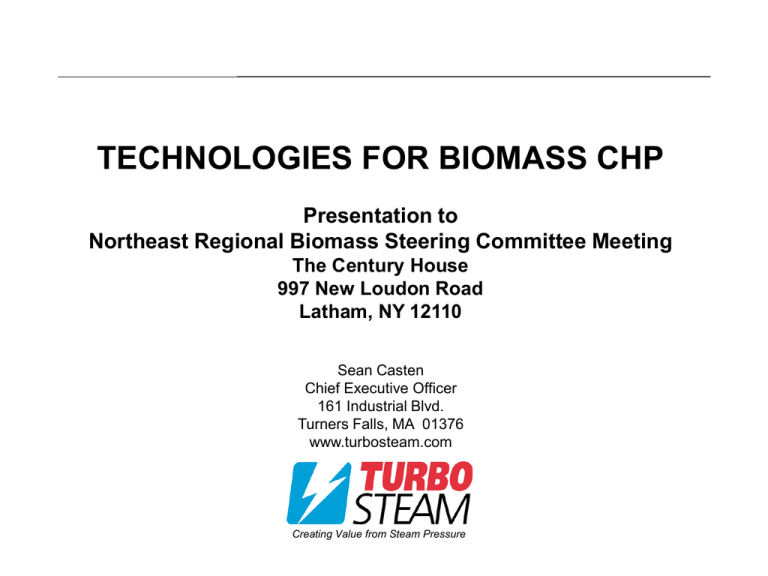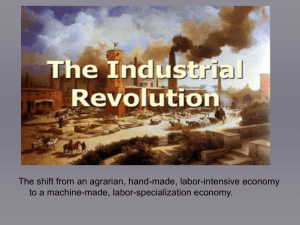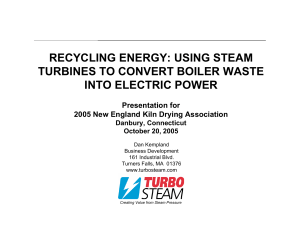Technologies for Biomass CHP - Recycled Energy Development
advertisement

TECHNOLOGIES FOR BIOMASS CHP Presentation to Northeast Regional Biomass Steering Committee Meeting The Century House 997 New Loudon Road Latham, NY 12110 Sean Casten Chief Executive Officer 161 Industrial Blvd. Turners Falls, MA 01376 www.turbosteam.com Creating Value from Steam Pressure Some thoughts on biomass as a fuel for combined heat and power generation. The Bad News The Good News • Without advances in gasifiers, you can’t burn it in the sexy power generation technologies • Gas turbines • Fuel cells • Microturbines • Etc. • The technologies biomass is suited to are also those used by the overwhelming majority of US power gen • 75% of all US power plants • 32% of all dedicated CHP plants The “problem” with biomass is common to almost all opportunity fuels, all of which are becoming ever more economically attractive as fuel and electric costs rise. Understanding 75% of US power generation in 30 seconds or less… Rankine Power Plant Fuel (Coal, oil, nuclear, gas, etc.) Boiler High Pressure Water Steam Turbine Generator Electricity to Grid High Pressure Steam Low Pressure Steam Low Pressure Water Heat to atmosphere Cooling Tower Pump Understanding biomass thermal energy plants in 30 seconds or less… Lumber Mill Energy Plant Pressure Reduction Valve Mill waste Boiler High Pressure Water High Pressure Steam Low Pressure Steam Low Pressure Water Heat to lumber Dry Kiln Boiler Pump The opportunity – convert H plants into CHP plants. Steam Turbine Generator Electricity to Plant Bus Mill waste Boiler Isolation Valve Isolation Valve Heat to lumber Dry Kiln Boiler Pump Several non-intuitive benefits of this approach. • Operating Savings: The presence of the thermal load makes this generation ~ 3X as efficient as the central power it displaces. • • Capital Savings: Since 75% of the power plant is already built, the effective (marginal) capital costs are quite low. • • • • More efficient than most other CHP technologies because all of input energy is recovered (comparable to a gas turbine that uses 100% of hot exhaust gas as hot air for a process). 1,000 MW Rankine plant typical capital costs ~ $1 billion ($1,000/kW) 1 MW steam turbine generator integrated into existing facility typical installed capital costs ~ $500,000 ($500/kW) Turbosteam has done fully installed systems for as little as $300/kW Similar logic applies to non-fuel operating costs, since most of Rankine cycle O&M are in the boiler and cooling tower. Turbine-generator O&M costs are negligible. • Long term Turbosteam service contract on 1 MW unit ~ 0.1 c/kWh Steam turbines come in two flavors – with infinite variety: backpressure (BP) and condensing (CX). • Thermal balance & fuel costs sometimes lead to excess steam in certain applications. When this happens, can make economic sense to combine BP and CX approaches to maximize power. Condensing (CX) Configuration HP Steam Electricity LLP Steam to condenser • • Backpressure/Condensing (BP+CX) Configuration HP Steam LP Steam to load Electricity LLP Steam to condenser Thermal plants are usually suboptimally designed for CHP. BPTG design often includes increases in boiler pressure and/or reductions in distribution pressure to boost power output. At the (confusing) extreme, this can enable condensing turbines in backpressure operation. Pure CX is NOT a CHP application, but can make economic sense where fuel is free/cheap. We have installed 112 systems in the U.S., and 180 worldwide since 1986. Non-U.S. >10,000 kW 5001 – 10000 kW 1001 – 5000 kW 501 – 1000 kW 1 – 500 kW • 17 countries • 68 installations • 37,343 kW 20 of these installations are in the lumber and wood products industries. 1988 1989 1991 1990 1992 1993 1994 1995 1996 1997 1998 1999 2000 2001 Buehler Lumber Brattleboro Kiln Dry • • • • Pompanoosuc Mills • • • • VT lumber mill 380 kW 18,000 lbs/hr Induction generator VT furniture mfr 50 kW 3,900 lbs/hr Induction generator Marcel Lauzon • • • • Quebec sawmill 335 kW BP+C design 17,000 lbs/hr Synch. generator Bell-Gates Lumber • • • • PA lumber mill 462 kW 20,700 lbs/hr Induction generator VT sawmill 75 kW 4,600 lbs/hr Induction generator Young Mfg Company • • • • KY millworks facility 120 kW 13,000 lbs/hr Synch. generator • • • • • • • • TN furniture mfr 825 kW BP+C design 34,000 lbs/hr Induction generator Bertch Cabinet Mfg Young Mfg Company • • • • KY millworks facility 200 kW 8,000 lbs/hr Synch. generator • • • • IA cabinet mfr 279 kW BP+C design 15,525 lbs/hr Induction generator NY furniture mfr 450 kW 24,150 lbs/hr Synch. generator Not shown: Kendrick Forest Products (50 kW, IA) and Ethan Allen (616 kW, VT) Webster Industries • • • • NY lumber mill 96 kW 5,000 lbs/hr Induction generator • KY hardwood products mill • 1,000 kW • 45,000 lbs/hr • Synchronous generator Bruce Hardwoods (2) • TN flooring mfr • 525 kW + 3250 kW • 40,000 lbs/hr + 50,000 lbs/hr • Synch. generators • • • • Cox Lumber Fitzpatrick & Weller Aristokraft • • • • Wightman Lumber WI lumber mill 550 kW, dual BP 27,600 lbs/hr Induction generator Worldwide installations, by industry • • • • • • • • • • • • • • Chemical/Pharmaceuticals Food processing Lumber & Wood Products District Energy Petroleum/Gas Processing Colleges & Universities Pulp & Paper Commercial Buildings Hospitals Waste-to-Energy Military Bases Prisons Textiles Auto manufacturing 28 22 20 19 17 16 11 11 8 6 5 2 1 1 Capex & Opex Considerations Capex • >1 MW, STG costs are reliably $500/kW or less (below this level, fixed engineering costs predominate) • Does not include boiler, condenser, piping costs. This alone makes the economics of backpressure much more compelling than condensers since the remaining infrastructure already exists. • Compare: modern central power plant typically costs $500 – 1500/kW. T&D adds another $1300. Opex • For BP, fuel efficiency = boiler efficiency (75%+ in biomass applications). • For CX, fuel efficiency is a direct function of inlet and exhaust pressure; at typical boiler pressures, efficiency is unlikely to exceed 20%. • Compare to central power @ 33%. CX only favored when fuel is very cheap. • Envt’l permitting tied to boiler; typically not required for BP applications • Operator requirements usually tied to boiler (MA exception) Marginal cost savings for backpressure and condensing steam turbine-generators. Marginal Power Generation Costs for Biomass Steam Plants Spread shows the value of heat recovery. As difference between these curves and elec value increases, more $ for cap recovery, profit, etc. Generation costs, $/kWh 0.120 0.100 Backpressure 0.080 Condensing 0.060 0.040 0.020 0.000 0 20 40 60 80 100 120 Biomass cost, $/dry ton (@ 15MMBtu/ton) Assumptions: 75% efficient backpressure, 20% efficient condensing. Actual condensing efficiencies are quite variable; this is the high end for most biopower plants. Costs for fuel only; O&M and capital recovery not shown. Assumes 15 MMBtu/dry ton biomass energy density A final idea – think like a CHP developer, and see how it changes your idea of how to make biopower work. • Try not to chase PURPA. Displaced power purchases (e.g., size to less than or equal to facility load) make for much better overall project economics than power exporting generators. – • Calculate marginal generation costs, then see if you can justify capex. Don’t “sell” projects based on your assumptions of capital costs & interest rates. – • Give yourself the opportunity to be financially creative. Learn to love efficiency, including heat recovery. – • Lots of rules of thumb about what biomass has to be to be economically competitive appear to undervalue the output energy. Too many plants chase minimum efficiencies to get PURPA limits and leave $ on the table. In energy markets, economic self interest gets you to environmentally good things – but environmental concerns independent of $ get you to end-of-pipe controls and advanced technology. Learn to listen to your wallet. – – – Chase energy efficiency rather than tax credits – may boost long term economics even while it compromises short term incentives. Cheap, proven technology is usually a better idea than expensive, unproven ones The biggest opportunities are often in system-level designs, not component-level advances







